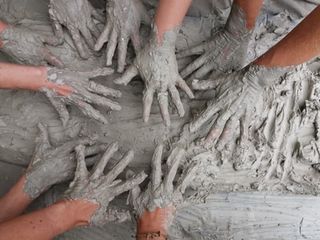Meditation
7 Unexpected Ways Clay Is Therapeutic
Transforming yourself one squish at a time.
Posted March 8, 2020 Reviewed by Ekua Hagan

Anyone who has squished a wet ball of clay won’t be surprised to hear me say it can be therapeutic. But if you’ve been following my posts, you know I like to wax on about the benefits of talk therapy and its key components: relationship, depth, and insight. So you might be surprised that today’s post focuses on the very non-verbal, sometimes solitary, practice of making pottery.
Pottery, and other ancient practices such as mindfulness and yoga, while therapeutic, are not therapy. Still, ceramicists have long extolled the restorative benefits of creating with clay.
The mechanisms for this are not always obvious to the non-practitioner so I caught up with some ceramic artists to ask them what they find therapeutic about playing with — or working with, for the more serious among us — clay. Their answers fall into seven overlapping categories.
1. Tactile gratification
Instead of brushes for painting and pencils for drawing, we use our hands for clay. Tactile contact — the first form of communication we learn as infants — is a very primal mode of expression. Cynthia Fox, a longtime user of clay told me, “I like the feel and dirtiness of the medium. It makes it feel more like my own work…. like more of me is reflected in the clay.”
“Yeah!” Kelli Blanchard, a psychotherapist who plays with clay in her free time, chimes in. “Seeing your own finger marks, intentional and accidental, means that a part of you is forever connected with every piece.”
Even a light touch on a lump of clay leaves an imprint. Our ability to make an impact — to transform something — is unmistakable while working with clay. Perhaps in that transformation, we are reshaping grief, guilt, memories. In changing parts of ourselves, we gain a sense of efficacy and of possibility.
2. Holistic experience
Creating with clay is a physical-sensual-mental experience. The physicality and limitless potential for creativity engages our muscles, fine motor skills, vision, and imaginations. We are simultaneously allowing unprocessed feelings to shape the clay while making detailed decisions about which direction we’d like to take our piece.
The artists I spoke with described feeling more fully alive when engaged with their craft. “All of my senses (apart from taste) are involved…and sometimes, inadvertently, taste too,” Ms. Blanchard said laughing.
3. Conscious and unconscious expression
Making art is an extension of ourselves. Through it, both our conscious and unconscious ideas and desires are expressed.
Clay is tangible, changeable, under our control in a world that often feels out of our control. We choose what bowl we want to throw or what body we want to sculpt. We choose to use our clay to send a message about the miracle of pregnancy or the repugnancy of xenophobia and enhance it with markings and colors of our choosing. Through trial and error, we get to know ourselves as an artist and a person.
Yet clay can also serve as a metaphor for our less conscious feelings and inner worlds. Wishes and fears are often found in both the process and product of ceramics. When we can let ourselves go, much like speaking freely in therapy, we make space for our fantasies and pain so they may be transformed into meaningful expression.
Robin Thom, who recently quit his job as a graphic designer and began selling his wares full-time at local art shows on the East Coast, explains he’s often surprised by what he creates:
“I’m fascinated right now by the muscles in the human body and trying to get more accurate in my sculpting. I set out to sculpt a woman with very defined muscles and succeeded, more or less, on one side of her body but the next thing I knew she was atrophied on the other side and spots covered her skin.”
Robin rolled his eyes and added: “So yeah, talk of a pandemic is obviously getting to me more than I realized.”
4. An antidote to the culture
We live in a culture that idealizes fast, easy and convenient. With the distractions of our devices and running from work to soccer games to meetings and dinners, we’re chronically harried. We wonder why we’re anxious and then seek out quick-fix therapies that often don’t last.
Working with clay means taking your time because the process can’t be rushed. There are about ten steps between preparing the clay and the glaze firing, some that require hours or days in between. If you try to rush it, the clay will make its resentment known by cracking, exploding, or rebelling in some other way. While this can be frustrating, Mindy Stillman, a licensed Clinical Social Worker, says it’s worth it: “Pottery makes me step away from the need for instant gratification because there’s a lot of waiting for completion.”
With clay, we also don’t always get what we want despite the hours of love and labor. We groom and beautify our pieces and pick colors that speak to us, hoping they look as we imagine after firing. And for the lucky or talented, they do. But the rest of us must learn to let go of control and accept imperfection. There’s no merchant to complain to or store to demand a refund. Meg Biddle, owner of the Lincoln Square Pottery Studio — Learning Center (LSPS-LC) in Chicago says, “It’s finding that balance between control and unpredictability that gives me joy.”
5. Release of aggression
Had a fight with your spouse? Throw clay hard and repeatedly on the wedging table. Cat peed on your bed…again? Beat the darn clay or cry on it. The thing with clay is you can slam, beat, and even stab it and it’s unlikely to be ruined, at least in its plastic state.
As studio owner Biddle notes, “Even if you let a piece get all the way to completion, you can decide to squash it at any moment, which gives you an in to the creation/destruction impulses in a way that’s safe.”
Even when a piece has been fired, you can take a hammer to it if you don’t want it. It brings enormous satisfaction…or so I’m told.
6. Meditation
Many of the artists I spoke with described clay work as a way to get out of their heads and into their bodies, much like meditation. Most people work alone on a project and there’s a kind of quiet, or flow-state, that comes over the artist as she allows herself to join the clay.
Ms. Blanchard, the psychotherapist, said: “Many of us use the creative space in the studio to balance and neutralize the ways that our careers require more rigid/structured thought. It stretches us in different ways…It's an extremely zen and meditative experience.”
7. Community
While pottery is usually solitary work, artists often work or take classes side by side at studios and tend to form a community. “The community itself is healing and inspirational,” explains Blanchard.
It becomes a space where smart talk about pop culture, politics, and shitty bosses abounds. More experienced artists often assist newer clay-mates, gaining awareness they have something to offer. There might be wine involved, which is especially lovely when a pottery teacher brings in various cheeses to use as examples of differing clay consistency, as Meg Biddle is known to do on occasion.
This adult playground is a much-needed reminder that there is more to the world than struggle and suffering. “Connecting with lighthearted, playful experiences is one of the most healing things we can do.” says Blanchard.
Ms. Stillman seemed to speak for most of the artists I talked to in summarizing her experience: “It allows me to step out of everyday chaos, listen to some great music, socialize and create.”
Conclusion
While writing this piece, I came to see a pattern of duality inherent in clay work. When we touch clay, we’re interacting with the earth, building a relationship with something that’s millions of years old. Yet we’re creating something brand new that has never existed before. Wrestling and joining with that slab of mud forces practitioners to seek the balance between control and unpredictability, seriousness and playfulness, detachment and attachment. The clay transcends into a beautifully finished piece of art and, while we may never be finished (and may still need therapy), we are one step closer to our own transformation.




